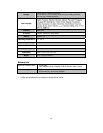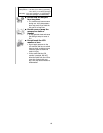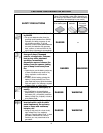
76
FOR CORRECT USE OF YOUR CAMERA
䦟 Cautions before capturing important
images
• Before capturing important images, make sure
that the camera is operating properly and in
condition to capture the images properly.
• Sanyo Electric shall not be held responsible for
any losses that result from images that could
not be recorded, are erased, destroyed, or
damaged in any way due to a problem with the
camera, any of its accessories, or its software.
䦟 Caution concerning copyrights
• The images you capture with your camera are
for your own private use; any other use may
violate the rights of copyrights owners.
• Please note that photography may be restricted
at stage performances, shows or exhibitions,
even in presentations whose purpose is
entertaining or amusing individuals.
• Also note that images that are intended to be
copyrighted cannot be used outside those limits
defined by the regulations of the relevant
copyright laws.
䦟 Cautions when cleaning the camera
Cleaning procedure
1. Turn off the camera and remove the battery.
(For safety, remove the power cord plug of the
AC adaptor from the power outlet.)
2. Remove the dirt with a soft cloth.
If the camera is extremely dirty,
3. Wipe with a soft cloth moistened with a mild
detergent diluted with water and wrung dry.
CAUTION
• Do not use benzene or thinner products to clean
the camera. Doing so may cause deformation,
discoloration, or paint peeling. When using a
chemically treated cloth, carefully read its
instructions and warnings.
• Do not spray insecticides or volatile sprays on
the camera. Do not let rubber or vinyl objects
contact the camera for a long period. They may
cause deformation, discoloration, or paint
peeling.
• Wipe the monitor with a soft cloth that has been
moistened with water and well wrung out.
Wiping with a cloth soaked with a cleaning
substance or chemicals will erode the finish or
cause it to peel.
䦟 Caution concerning the battery
• Periodically clean with a dry cloth the terminals
(contacts) of the battery. Do not touch the
battery terminals with your bare hands. Doing
so will allow contaminants from your hands to
adhere to the terminals and oxidize, increasing
the contact resistance. If the contact resistance
increases, the usable life of the batteries will
diminish.
䦟 Caution when cleaning the lens
• If the lens gets dirty, use a commercially available air
blower or a cleaning cloth for photographic
equipment to clean it.
䦟 When not using the camera for a long period
• Remove the battery. However, when the battery is
removed for a long time, the camera functions may
begin to not work properly. Periodically reinstall the
battery and check the camera functions.
• If the battery is left in the camera, a small amount of
power is still used even if the camera is turned off. If
rechargeable batteries are left in the camera for a
long period, they may become completely discharged
and lose their ability to be recharged again.
䦟 Cautions concerning condensation
• Using the camera with condensation inside it may
damage the camera.
If condensation seems likely to form
• Place the camera in a plastic bag and seal it, and then
wait until the camera has reached the ambient
temperature.
Be careful of condensation under the following
conditions
• When moving the camera suddenly from a cold place
to a warm place.
• When the ambient temperature changes drastically,
such as when a heater is turned on to quickly heat the
room.
• When the camera is placed in the path of cool air from
an air conditioner.
• When the camera is placed in a location of high
humidity.
䦟 Caution concerning undesired interference
• The camera may create undesired interference if used
close to a television or radio. To avoid this type of
interference, make sure the cores on the supplied
cables are not removed.
Dedicated USB interface
cable
Dedicated S-AV interface
cable
Core Core
* The type (shape) and quantity of cable(s) supplied
may differ depending on which product was
purchased.
• If the docking station or AC adaptor/charger is used
in close proximity to a radio or TV set, it may cause
interference such as static in AM broadcast signals or
noise in the TV image. In this case, increase the
distance between the radio or TV and the device.


















